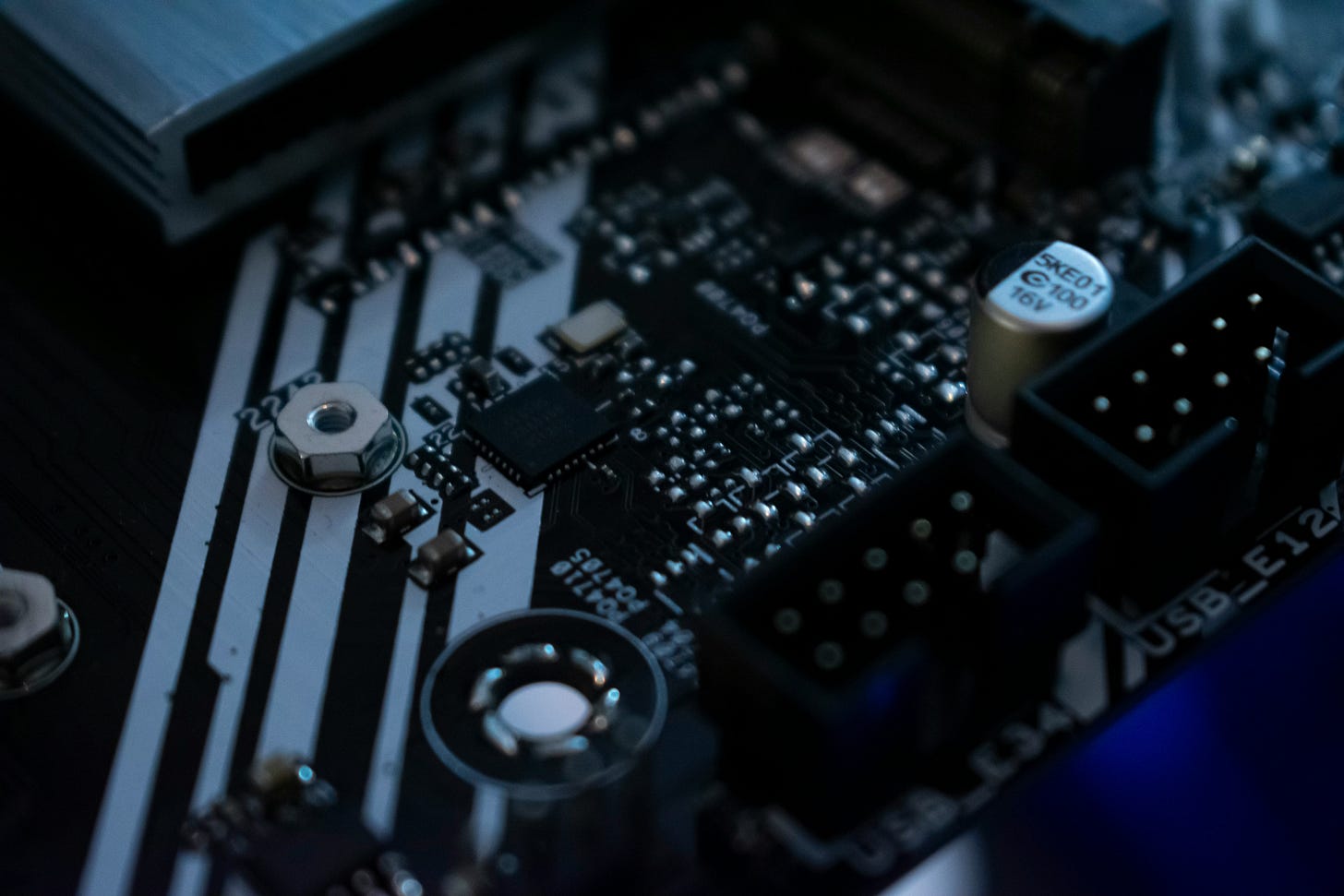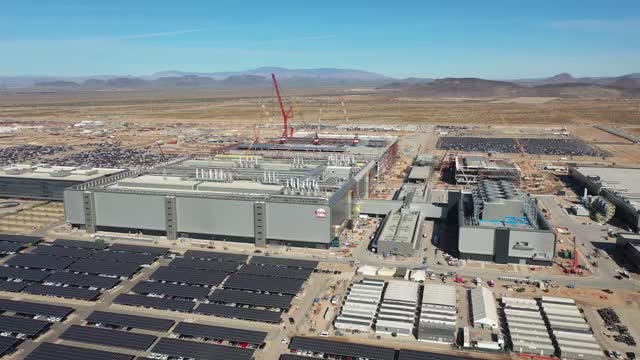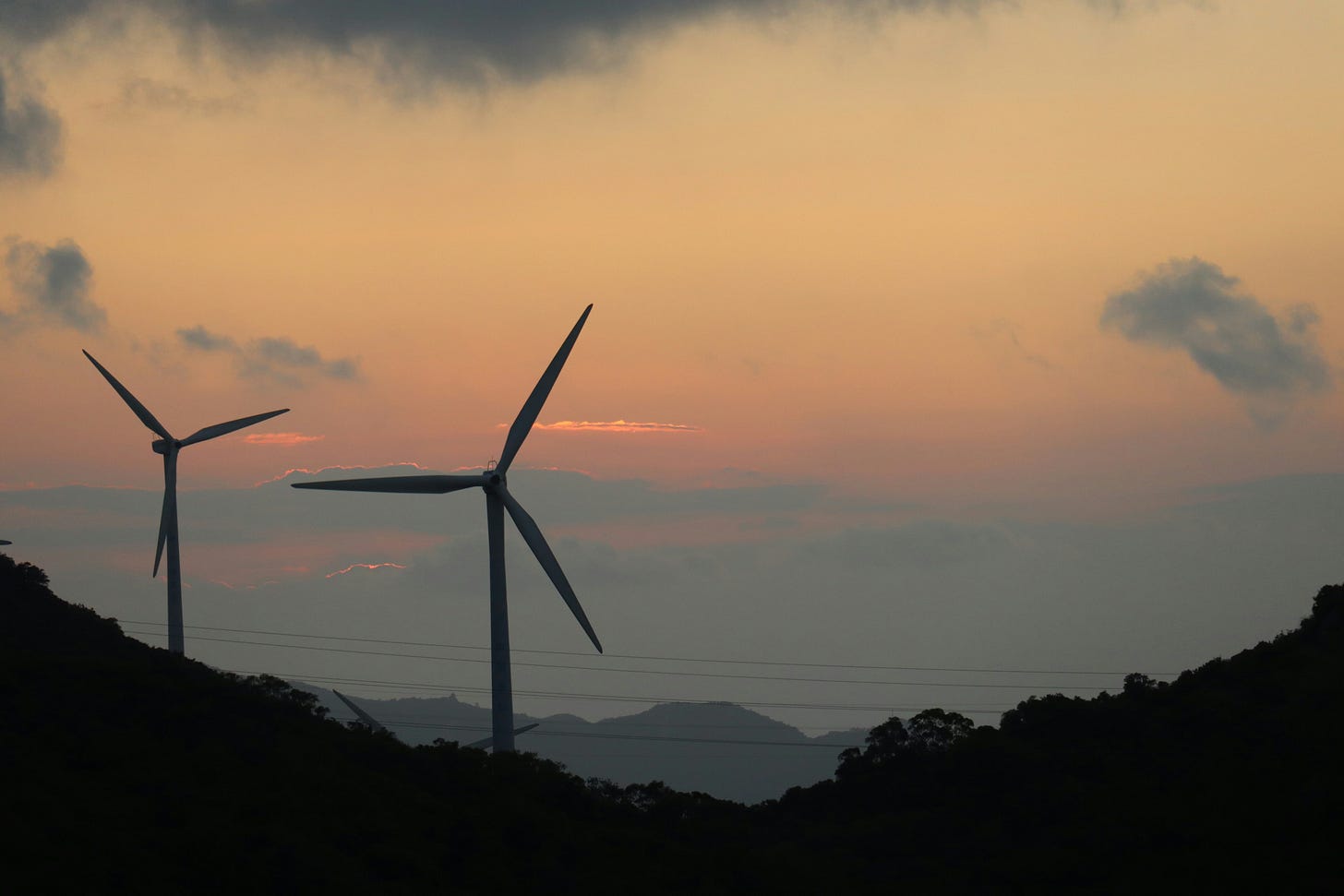The End of The Age of Silicon
Why Moore’s Law's Collapse Will Reshape Everything
Grüezi!
1. The Wall
A silicon atom is 0.2 nanometres wide. At 2nm, the world’s cutting-edge chip structures are just ten atoms across. There are no half-atoms. We’re not talking about an engineering challenge – we’re talking physics.
The move from 7nm to 5nm chips took twenty-four months. From 5nm to 3nm it was thirty. Now from 3nm down to 2nm, it’s thirty-six and counting.
TSMC’s official disclosures track exactly what the deceleration means. The 7nm to 5nm delivered 15% speed improvements and components 37% smaller. The 5nm to 3nm transition managed 10–15% faster with components only 20–30% smaller. For 3nm to 2nm, they’re “targeting” 10–15% faster and “over 20%” smaller.
Confidence is draining from the details. “Will achieve” becomes “targeting,” ranges widen, numbers shift to aspirations. Where the industry could once improve chip density by 30% every two years, it now sees half those gains every three to four.
This is how Moore’s Law ends – not a slam stop, but a gradual loss of momentum.
Manufacturers can still improve transistor architecture, reduce interference by separating power delivery from signal routing, and likely squeeze chips from 2nm down to 1.4nm. But every advance requires more capital, more time, and delivers less progress than its predecessor.
Exponential gains weren’t just a feature of semiconductor technology – they were the compounding multiplier driving everything else.
Economic models, AI infrastructure spending, weapons strategies, startup valuations, development economics, Silicon Valley techno-optimism – all assumed computing capability would keep compounding at historical rates. When the exponent drops from 0.3 to 0.1, everything shifts.
There aren’t alternatives that can help.
Quantum computing is useful for specific tasks but requires near absolute zero temperatures and isn’t a general replacement.
Photonic computing can improve data centre networking but can’t replace processors in phones or laptops.
Carbon nanotube transistors work in labs but manufacturing them at scale has been tried for two decades with no commercial breakthrough.
The industry has shifted strategy without admitting it.
Instead of simply making transistors smaller, companies now stack chips vertically, connect them more efficiently, improve packaging density. It’s genuine engineering progress, but optimisation rather than transformation.
When Cerebras Systems announced its latest wafer-scale engine in 2024, the company used 5nm process technology rather than waiting for more advanced nodes. Not because it couldn’t access newer processes, but because it had stopped expecting dramatic advances from waiting.
2. The Capital Trap
OpenAI lost about $13.5bn in the first half of 2025, and in Q3 looks likely to lose another $11.5bn. Microsoft, Google, Amazon, and Meta committed $300–380bn to AI infrastructure in 2025, assuming rapid hardware improvement would make their investment pay back.
The business logic only works if chip performance improves at historic rates. With exponential gains, facilities built today appreciate rather than depreciate – software engineers refine code for each new chip generation, and those refinements make older infrastructure more effective than when installed.
A data centre filled with 2023 chips runs better in 2027 because software gets more efficient. That’s the moat – years of incremental improvements whilst competitors plan.
When chip improvement slows, infrastructure just depreciates. It looks less like a moat, more like a ditch.
This is the capital trap: investments sized for exponential outcomes generating logarithmic returns.
The gap between expectation and reality is closing slowly enough for participants to adjust, but painfully enough to mean write-downs, stranded assets, and failures that will echo through the economy.
The implications are the same for military planners, just with longer time horizons. American defence takes continuous hardware improvement as given. F-35 avionics, hypersonic missile guidance, satellite networks – all designed assuming chips available in 2030 will be substantially better than today’s.
If the leading edge looks much the same in 2030, with marginal gains rather than generational leaps, US military technology advantage starts to look fragile.
3. The Demographic Scissor
Technology progress is slowing whilst the world it serves is aging.
In Japan, 30% are now over 65; the United States and Europe are heading that way within a couple of decades. By 2050, over-65s will be one in six people globally. And that changes how you spend.
In the United States, healthcare spending for over-75s rises to almost an eighth of household budget. Money spent on technology and entertainment drops sharply.
Over-50s control more than half of US consumer spending but only get 5–10% of marketing budgets because marketers already know what old people buy.
Technology will pivot towards medical applications – diagnostic AI, drug discovery, aging-in-place robotics. But healthcare tech spending, even at scale, can’t match the semiconductor intensity of consumer electronics and enterprise software that drove demand for four decades. Healthcare is labour and pharma – tech is only a fraction of each pound spent.
Meanwhile, population growth is concentrating in Sub-Saharan Africa and parts of South Asia. Africa will add 900m people by 2050, representing two-thirds of global population growth. Nigeria alone could reach 400m people, making it the world’s third-largest nation by mid-century.
But Africa’s total GDP sits around $2.8tn – roughly 3% of global economic output despite having nearly a fifth of global population. Even with sustained 5% annual growth optimistically compounded, to reach 10% of global GDP would take seven decades. At that point, Africa would have one-third of world population but a tenth of its economic output.
The AI infrastructure boom assumes growing markets for advanced computing services exist and are ready to pay. But the markets that can afford these services age into demographics that don’t consume technology products the way younger populations do, whilst markets with young, rapidly-growing populations can’t afford what advanced chips make possible.
This is the demographic scissor: capability to produce advanced technology concentrated in aging economies with declining consumer demand, whilst population growth pools in young economies with no purchasing power.
The development path that worked for four decades assumed technology kept improving and eventually became affordable for poorer markets. Smartphones reached Africa because each generation got cheaper whilst capability increased, creating diffusion where last year’s premium technology became this year’s mass-market product.
But when the state-of-the-art stops racing ahead, this mechanism breaks. Advanced AI infrastructure deployments concentrate in wealthy markets with the purchasing power to afford them, whilst young, growing populations face widening technology gaps.
4. The Energy Inversion
Here’s what changes the calculation entirely: energy is scaling faster than transistors. And nowhere is electrifying like China.
Training GPT-4 consumed roughly 50 gigawatt-hours – enough to power San Francisco for three days – and next-generation models at are expected to require substantially more. Global data centre electricity is forecast to reach 945 terawatt-hours by 2030 – roughly Japan’s annual consumption – and more than double 2024 levels.
Chip-for-chip, Huawei’s top-of-the-line Ascend 910Cs can’t match Nvidia’s equivalents. But the company has a solution: massive clustering enabled by abundant cheap power. Where Nvidia designs for maximum performance per watt, Huawei designs for adequate performance at scale, trading less efficient silicon for cheaper joules.
Chinese local governments are now subsidising electricity bills for data centres using domestic chips. Beijing has linked industrial policy to grid reinforcement, developing large solar projects in Inner Mongolia, expanding hydropower in Sichuan, building high-voltage transmission lines to move cheaper inland electricity to coastal demand centres. Energy cost reduction is outpacing technology innovation.
This flips long-held assumptions about technology leadership. The United States retains decisive advantages in chip design and can restrict China’s access to cutting-edge manufacturing equipment.
But America cannot restrict access to sunlight, wind, or the infrastructure investments Beijing makes to capture them.
5. The Island Problem
Taiwan Semiconductor Manufacturing Company controls over 90% of the world’s most sophisticated chip production.
Not all chips – plenty of companies manufacture mature nodes for applications not needing cutting-edge performance. But at the cutting edge – 3nm and 2nm technology for AI training, advanced smartphones, F-35 fighters, missile guidance systems – TSMC’s dominance is almost absolute.
That concentration is fifty years of accumulated expertise, infrastructure investment, supply chain integration that cannot quickly be replicated. TSMC employs some 75,000 people with specialised knowledge that exists nowhere else at comparable scale.
Intel has spent years and tens of billions attempting to match TSMC. Samsung has resources and decades of semiconductor experience. Both have struggled. Delays in Intel’s 7nm chip production forced it to outsource its own designs to TSMC. Samsung’s foundry yields at advanced chips are so far behind TSMC’s that customers choose it despite desperately wanting to hedge their geographic bets.
China’s progress demonstrates both the technical challenge and how silicon deceleration changes calculations. In 2023, Huawei brought out a smartphone with a domestic 7nm chip manufactured by SMIC – impressive engineering using older equipment rather than cutting-edge Dutch lithography that is blocked by US export controls. Industry estimates put SMIC’s 7nm yields at 30–50%. TSMC’s exceed 90%.
But 7nm is sufficient for many military applications, telecommunications infrastructure, industrial uses, consumer products. With silicon stalling at 2–3nm, China’s current capability is shifting from “hopelessly behind” to “adequate for most purposes.” The gap is shrinking because the frontier has stopped moving, and China is getting more time to close it.
In 2024, Nvidia sold over a million H20 chips in China – downgraded processors designed to comply with export restrictions. Huawei sold 200,000 domestic AI chips despite lower performance. That 5:1 ratio will narrow as Chinese yields improve, software matures, energy advantages kick in.
Current American policy faces a strategic bind: it seeks to defend Taiwan to preserve access to advanced fabs, whilst simultaneously reducing dependency on Taiwan to eliminate that strategic vulnerability.
The more successfully it reduces dependence, the less strategically vital Taiwan becomes – undermining the rationale for its defence.
The 2022 CHIPS Act provided $53bn in grants and loans plus tax breaks worth $24bn to encourage domestic US semiconductor manufacturing. Nearly $7bn went to Arizona facilities run by TSMC, plus $5bn in loans to support the company’s $40bn investment.
The Arizona fabs began 4nm production in late 2024, with 3nm targeted for 2028 and 2nm for 2029. But the facilities operate mostly with engineers rotating in from TSMC’s Taiwan operations – the expertise is borrowed rather than developed domestically. If Taiwan faces a crisis severe enough to disrupt operations, that rotation stops, and the knowledge transfer pipeline breaks.
American fabs might operate with substantially domestic workforces at competitive yields by 2040 – the optimistic timeline. By then the technology will have plateaued.
Taiwan remains essential but no longer irreplaceable. As the gap narrows, so does the logic for accepting Taiwan’s geopolitical risk.
6. The Plateau Transition
Two AI ecosystems are diverging – not one simply lagging the other, but optimising for fundamentally different constraints:
The American way – unrestricted hardware access, abundant capital, market-driven allocation.
The Chinese path – restricted hardware, open-source software, state-shaped coordination, energy abundance.
Neither guarantees success. American firms face deteriorating hardware economics whilst capital costs peak. Chinese firms face software maturity challenges and persistent dependencies on foreign equipment.
American firms face market discipline – capital exhaustion if returns don’t materialise, valuation drops if productivity gains disappoint. Chinese firms face political discipline – resource allocation decisions made through party rather than profit signals.
Both systems face adjustment pressures, but also different potential pitfalls. Market systems risk catastrophic misallocation from irrational exuberance – the capital trap at scale. State-directed systems risk sustained inefficiency when political objectives override technical and economic ones – the planning penalty.
Market systems excel at frontier racing – rapid iteration, risk-taking, creative destruction that adapts to track moving targets. State-directed systems excel at coordinated adjustment – managing transitions across supply chains, aligning infrastructure investment with industrial policy, sustaining development when market signals break.
For seventy years, the frontier raced ahead and market systems dominated. The plateau is a test of institutional capacity, and the outcome is yet to be determined.
7. Entering Log Time
The End of the Silicon Age doesn’t mean the end of computing. It means the end of exponential improvement as the governing dynamic of technological progress – the decay of the underlying multiplier that powered the past half-century’s trajectories.
Global productivity growth has slowed significantly since the mid-2000s and will likely slow further as the computing tailwind becomes a headwind. Inflationary pressures rise as digital deflation recedes, changing the macroeconomic environment that policymakers and markets have internalised over three decades.
Hardware monopolies will deepen as fewer firms can afford next-generation fabs with diminishing enhancement economics. The middle tier of the semiconductor ecosystem will be squeezed – companies can’t justify the capital intensity of leading nodes when gains are marginal, but can’t compete effectively at mature nodes when Chinese manufacturers have cost advantages.
The United States loses the assumption of perpetual technological lead that’s structured American grand strategy since 1945. Not because American technology stops advancing, but because the edge itself stops racing ahead fast enough to maintain decisive gaps.
Since the mid-20th century, developed societies internalised exponential progress as normality rather than anomaly. It became an ideology of inevitability – the assumption that technology would always deliver faster, cheaper, better, that problems would be solved by future capabilities rather than present trade-offs.
They will now misprice reality systematically until they acknowledge its end, and the mispricing will be most severe in organisations with the longest planning horizons – defence procurement, infrastructure investment, pension fund management, development economics. These institutions are least capable of rapid adjustment because their decision cycles stretch across decades.
The world is reverting to log time: slower, denser, more path-dependent, where decisions have lasting consequences because you can’t count on future technology to erase present mistakes.
The age of automatic acceleration is over.
What follows is the era of earned progress, and we need to institutionally, intellectually, and emotionally prepared for what that requires.
Thanks for reading!
Best,
Adrian









